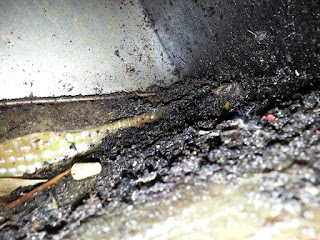WE MADE IT!
Captain's Log, splash date June 20, 2013. With a bit of hesitation she made it in the water. The hesitation came after we picked her up, shortly before lunchtime, and set her in the water with the travel lift. See picture below of her moving from her dry berth via the travel lift towards the water.
I groaned out loud as we did the normal inspection of all thru hull penetrations while she was still hanging in the slings in the lift bay and found that one of the original 40 year old thru hulls was leaking (into a nice clean bilge anyway) see photo below.
So out she came to have the situation remedied. We left her hanging in the travel lift for a couple of hours while the old thru hull was removed to be re-bedded with fresh caulk. This thru hull assembly consists of three parts, a threaded fitting that goes through the hull, a valve that screws onto it from the inside, and a plywood backing plate that is sandwiched in between the two on the inside of the hull. We could not unscrew the valve from the threaded fitting so we had to cut the old one out with a sawzall reciprocating saw, see photo below of the result as viewed from the outside.
Joe Reid made pretty quick work of the process and once the threaded fitting was cut away he could take the pieces that were stuck together into the shop and put the valve in a bench vise and unscrew it for reuse on a new threaded fitting with a new plywood spacer. While he was doing that, my mechanic, Keith, and I removed the dead engine start battery and I took it to the Battery Warehouse to get a new one. Yea, that battery had shown life all winter but sat for a month off the charger while work was being done and it died. So $185 lighter of pocket I returned with a new battery. This was no mean feat as this was an 8D wet cell battery that weighs over 150#, we had to lower it from the boat onto the ground with some skinny rope and I have the rope burn on my right hand to prove it. We were smart enough to wait until the boat was back in the water before we placed the new one aboard. Much easier to move the battery sideways from the ground onto the deck than to lift it up seven feet in the air.
So once that fire drill was done it was off across the harbor via a tow boat to get some new, fresh fuel.
After fueling up we towed her back across the harbor and resumed working on her, the engine work was not yet complete and the platform hatches that cover the engine were still being adjusted for a final fit. By the end of the day Keith had run the engine "pretty good and pretty hard" for 3/4 of and hour and pronounced her ready for sea! It took the rest of the day on Friday to complete the engine hatch installation and it took me the rest of the day and into the evening on Saturday to finish up some other tasks, like connecting the head to the holding tank, installing the running lights and connecting the forward water tank to the head intake to provide a dedicated fresh water rinse. After loading the boat with supplies she was ready to make her maiden voyage eight miles away to Galesville for the annual Summer Solstice Raft Up. The weather at the marina was clear and the wind moderate so I fired her up and left the dock at 9PM bound for the aptly named Galesville. Aptly named as I discovered because once I left the harbor and headed out the mouth of the South River and into the bay the seas quickly began to rise and the wind began to carry a fair amount of spray into the pilothouse. The water was warm and felt good to be out at last but later I wished I had taken the time to close the windows. I was preoccupied with drinking a victory beer, keeping course and taking some engine data readings: boat speed, engine rpms, oil pressure, water temperature and sound pressure level readings when I got my first reminder of how quickly things can change on the bay, whoosh came the solid green water over the bow, over the forward cabin house and in through the pilothouse window whisking my beer off the shelf and drenching me. OOOOOkay, this is going to be an interesting shake down cruise. I should have started this story off with "it was a dark and stormy night". It was too rough to stop and close the windows and if I had the spray would have obscured my vision through the glass because I had not yet completed the windshield wiper installation so I just had to soldier on with the window open. I also discovered in this adventure that wet hands on a wet cell phone screen disable the touch and swipe feature that you need to use to make the phone work and in this case I was using a navigation app on my cell phone to help find my way in the dark. Gee, now I really, really wish I had finished the windshield wiper installation. But, all's well that ends well and as this was not unfamiliar waters for me I was able to feel my way around Saunders Point Shoal into the West River and into the harbor at Galesville. Here is a chart of my route. Note the wind direction over the three shoals. The steady 18 knots gusting to 24 and running against the outgoing tide and flow of the South River are what really bumped up the wave height beyond the reported 2 ft waves from the weather buoy off the mouth of the Severn River.
And here we are the next morning, thanks to Emerson for the impromptu photo of me tied up at the end of the raft.
Still lot's to do, the platform hatches have to be finished, the potable fresh water tank plumbed into the system, THE WIPERS REALLY NEED TO BE FINISHED, the new chartplotter installed, fans wired, bug screens fabbed and an autopilot is really looking more important too so that I can take my hand off the wheel long enough to pick up the empty beer can off the floor and replenish it with a full one. But in any case, I am in the water and look forward to a nice summer of calm seas and fair winds. Thanks to all who have taken the time to visit my blog. That's it for me and my blog, farewell all.
Dennis































































